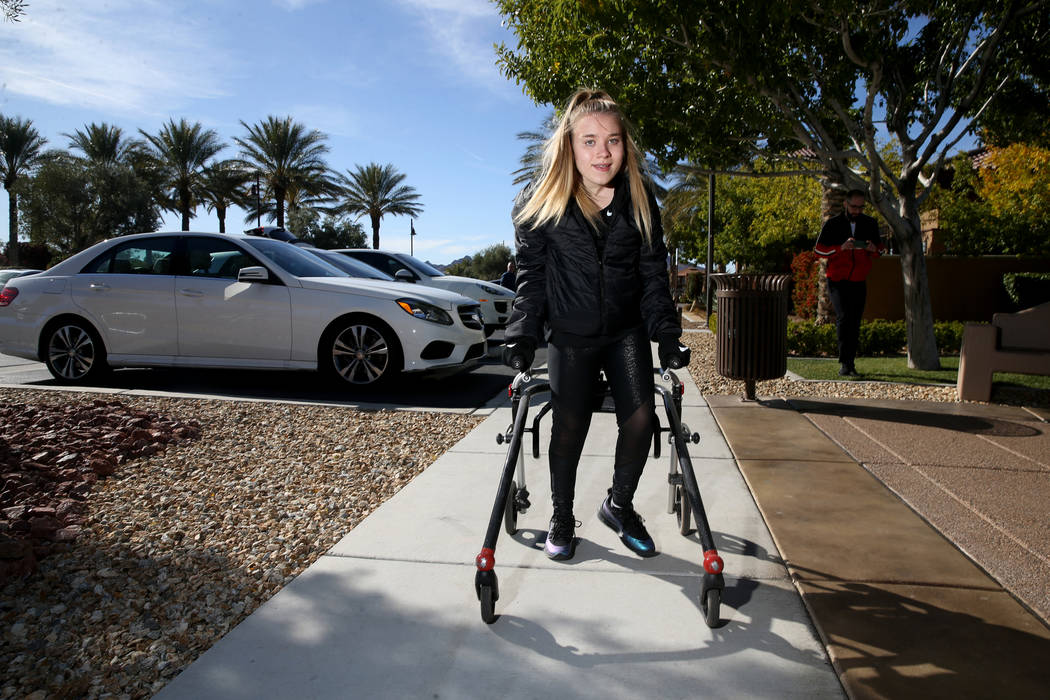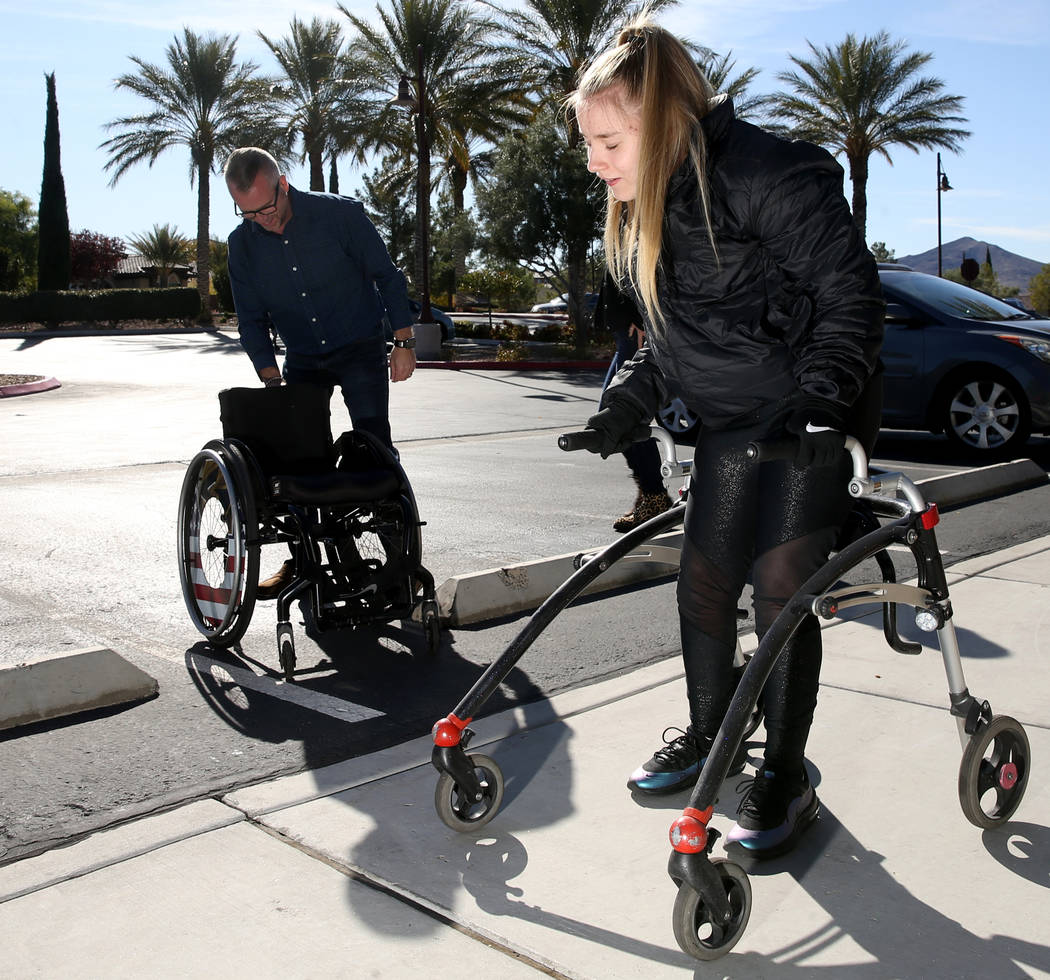Liberty High School junior won’t let cerebral palsy slow her
Mena Hawkins smiles with every step she takes.
Well, almost every step.
Fatigue finally sets in, and her smile starts to fade while she walks at a park near her Henderson home on a brisk Tuesday morning in late November. But it reappears as she recovers after a moment’s rest. Then it’s back to walking, albeit ever so slowly.
Left, right. Left, right. Left, right.
Back to smiling. Back to raising $7,000 for charity.
Hawkins, 17 and a junior at Liberty High School, was born nine weeks premature in Northamptonshire, England, and diagnosed 18 months later with cerebral palsy, a set of disorders that affect balance and posture. Her condition in particular featured an uncanny muscular spasticity that limited her mobility, preventing her from walking the most trivial of distances without a painful scissor in her gait.
Forget about a mile. Anything beyond a few feet was practically impossible.
But a breakthrough surgical procedure in 2013 loosened her muscles, igniting an interest in distance walking. And for the last eight months, she’s trained almost every day with her reverse walker for the mile race at the 15th annual Las Vegas Great Santa Run — all while raising thousands of dollars for Opportunity Village, a local nonprofit organization serving adults with disabilities that benefits from the proceeds of the race.
Hawkins actually completed the mile after her surgery in 2013 several minutes after the race had finished and the streets had reopened. She toured Opportunity Village earlier this year, though, and sought to bring awareness to the organization by completing the mile again.
Only faster.
Much faster.
“I found it really difficult the first time around,” she said with a grin, recalling the exhaustion in her legs from the first race. “Now I feel a lot more prepared.”
The surgery
Roger and Debbie Hawkins were raising two other children when Mena was born and were plenty familiar with the typical rigors of parenting. So they quickly recognized the peculiar developmental patterns during their youngest daughter’s infancy. She was mobile, but not as mobile as her siblings. She could crawl, too, but not as deftly as they crawled.
“She wouldn’t try to get up on the furniture,” Roger recalled.
“She would always be tense and stiff. Just the whole pattern of development for a child was completely different,” Debbie added.
After her diagnosis, Mena’s childhood was shaped by the limitations of her condition. She spent many days working with therapists in an effort to maximize the functionality of her limbs. There were no play dates at the park with her peers.
Just daily appointments with adults.
“It’s borderline weird (or) sad that she missed some elements of her childhood,” said Roger, who relocated with his family to Las Vegas in 2007 and owns a consulting company. “Going out with her friends. Running around on the streets. Doing those kinds of things.”
Hawkins did learn to walk with her reverse walker, but the spastic tension in her muscles limited her output and the distances she could cover to “a matter of feet,” according to her father.
Again, forget about a mile. Practically impossible — that is, until her family learned about the selective dorsal rhizotomy procedure at St. Louis Children’s Hospital. The surgery, performed by Dr. T.S. Park since 1987, involves cutting some of the nerves from muscles attached to the spinal cord.
It’s the only procedure that can permanently reduce spasticity, according to the hospital’s website, and not everybody with cerebral palsy is a candidate for the surgery.
“Basically, we need to see the potential for children to improve after surgery,” Park said while explaining in layman’s terms the necessary qualifications for candidacy.
He saw that potential in Hawkins, and her family applied for candidacy by submitting medical records, videos and screenings to Park, a pioneer of the procedure who has performed it more than 4,000 times.
Mena underwent successful selective dorsal rhizotomy in July 2013.
“If she didn’t have surgery by this time, she would have been in a wheelchair,” Park said.
The race
Hawkins doesn’t hesitate to speak on the success of her surgery.
“It changed my life,” said Hawkins, who uses a custom Vegas Golden Knights wheelchair when she’s not walking. “It took away the uncomfortableness from what I used to have.”
But she didn’t begin walking overnight. Far from it.
Her legs were weak and limp after the procedure. Her mother compared them to a newborn baby’s. And Hawkins needed to begin building muscle well before she could walk.
So she began going to the gym in her living community, building strength in her legs and core with basic exercises while also undergoing physical therapy. Slowly but surely, she started walking with her reverse walker. And after five months of rehabilitation, she completed one mile in the Great Santa Run in roughly 90 minutes to establish a benchmark in her recovery.
“I was the last person to get there,” she said. “(But) I made it to the end.”
All the while, the reduction in spasticity alleviated some of the daily complications from her cerebral palsy. Moving around the house became easier. Getting to and from school became easier. Appointments with therapists became infrequent.
She decided on a whim at the beginning of the year that she wanted to walk one mile again at the Las Vegas Great Santa Run.
“I just felt like I wanted to do it,” she said. “I got the urge that I wanted to do it, so I started training.”
With the support of her parents, Hawkins began training in March by walking through the hilly streets of her community and exercising again. Her stamina has gradually improved over the past eight months and she now regularly walks 1.1 miles to a local coffee shop. She stops sporadically to catch her breath, but her breaks per walk have decreased throughout her preparation.
Her family toured Opportunity Village’s campus in July, and Hawkins said she was inspired by the impact the organization has on adults with disabilities in Southern Nevada. Her family partnered with Opportunity Village shortly thereafter to launch a fundraiser on her behalf.
She’s generated more than half the $12,226 the organization had raised as of Friday afternoon.
“I didn’t expect her to raise as much money as she did,” Santa Run race director Casey Parisi said. “It’s something that was very inspiring to us because of the people we serve.”
Hawkins concluded her training Thursday with a half-mile walk and rested Friday. Opportunity Village is honoring Hawkins before the race by welcoming her family onstage near the course.
Her parents say her self-confidence has flourished through her training now that she’s stronger and faster than ever before. She hopes to walk the mile in 42 minutes, and, no, the streets won’t reopen before she finishes this time.
“I’m nervous, but I’m excited at the same time. But there’s a lot that goes into the actual day,” Hawkins said. “I can’t wait to get to the finish line of the race.”
To donate to Mena’s Santa Run team, visit LVSantaRun.com.
Contact reporter Sam Gordon at sgordon@reviewjournal.com. Follow @BySamGordon on Twitter.





















